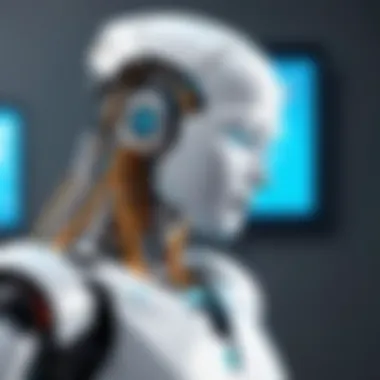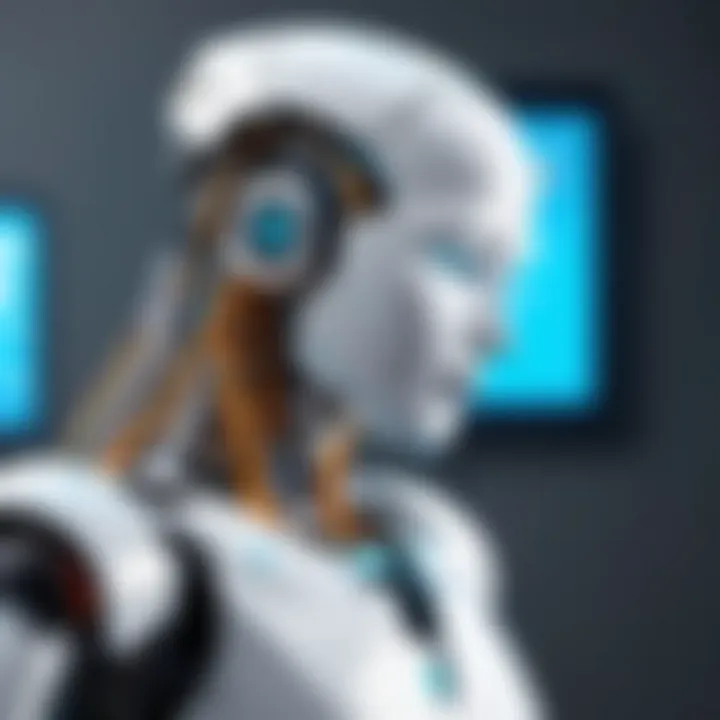Exploring Robot Lessons in Contemporary Education


Intro
In recent years, the influence of robotics in education has been profound. With technology advancing rapidly, the necessity to adapt teaching methods is clearer than ever. Robot lessons bring together intricate skills that prepare students for a future dominated by technology. The integration of these lessons not only enhances understanding of robotics but also fosters critical thinking, problem-solving, and cooperation among students.
The modern classroom is evolving. No longer just a place for rote learning, it now acts as a dynamic environment where creativity and innovation can flourish. Teachers are challenged to develop curricula that are engaging, relevant, and aligned with technological advancements. Programs integrating robotics can help students to connect theoretical knowledge with real-world applications, enriching their overall educational experience.
This article will navigate through the fundamental aspects of robot lessons, highlighting their significance in contemporary teaching. We will explore the pedagogical strategies that educators employ, the importance of curriculum design that incorporates technology, and the implications of embracing robotics in the classroom.
Technology Insights
The integration of robotics into education does not exist in a vacuum. It is essential to acknowledge the technology trends that shape robot lessons and their implementation in schools. Educators leverage cutting-edge tools and frameworks to facilitate effective learning experiences.
Latest Tech Trends
- Artificial Intelligence: The use of AI in educational robotics enhances personalization, allowing students to learn at their own pace. Tools like the VEX Robotics and Wonder Workshop’s Dash incorporate AI, tailoring lessons to individual needs.
- Internet of Things (IoT): IoT devices bring robotics into real-world applications. Students learn to program devices to interact with their environments, promoting hands-on experience.
- 3D Printing: Prototyping with 3D printers alongside robotics teaches students about design and engineering principles, bridging the gap between concept and creation.
Innovation in Tech
Technology is constantly innovating, leading to new opportunities for educational reform. Companies like Lego Education and Sphero are pushing the boundaries with products that blend learning and play. This creates an engaging atmosphere while teaching students about robotics and coding.
Product Reviews
A deeper look at various robotics kits modified for educational purposes can indicate which resources are most effective. For instance, the LEGO Mindstorms EV3 allows for extensive creativity through building and programming, making it a popular choice among educators. Another noteworthy product is the Makeblock mBot, known for its user-friendly interface, appealing to younger students entering the world of programming.
"Robotics education is pivotal in cultivating skills such as critical thinking and collaboration. The future workforce will demand these competencies as technology evolves."
Understanding these technology insights lays the groundwork for effective discussions on how robot lessons can transform education and prepare students for a tech-driven future.
An Prelims to Robot Lessons
The integration of robotics into educational environments is a significant development in modern pedagogy. This introduction sets the stage for understanding how robot lessons are influencing contemporary education methods.
Robot lessons go beyond mere technology incorporation; they offer a hands-on, interactive learning experience. They facilitate an engaging way for students to grasp complex concepts. Through the use of robots, educators can present real-world scenarios that promote problem-solving and critical thinking.
By analyzing robot lessons, we can see several key benefits that they offer:
- Enhanced Engagement: Students show higher levels of enthusiasm when interacting with robots, as it combines learning with play.
- Skill Development: Lessons focused on robotics encourage skills such as programming, engineering, and teamwork. These skills are essential in today’s tech-driven society.
- Interdisciplinary Learning: Robotics often merges various subjects, such as science, technology, engineering, arts, and mathematics (STEAM). This holistic approach prepares students for real-world challenges.
Despite these advantages, there are essential considerations for educators. Implementing robot lessons requires training for teachers to ensure they can effectively facilitate the programs. Additionally, the cost of resources may pose barriers for some institutions. Understanding these factors is crucial before integrating robotics into curriculums.
In summary, the introduction of robot lessons marks a pivotal transformation in educational practices. The focus is not merely on learning about technology but using it as a tool to foster essential skills. As we explore this topic further, it is important to recognize its implications for both students and educators alike.
The Evolution of Robotics in Education
The field of robotics in education has undergone profound changes over the past few decades. The integration of robotics into educational frameworks reflects an acknowledgment of the skills necessary for a rapidly advancing technological landscape. Understanding this evolution provides insights into the benefits and considerations of implementing robot lessons in contemporary education.
Historical Context
Robotics as an instructional tool began to gain traction in the late 20th century. Initially, the focus was primarily on teaching basic programming skills. Early robots were mostly simple, programmable devices used in specialized settings, such as engineering courses or technical schools. These basic interactions laid the groundwork for learners to understand fundamental programming concepts.
As technology advanced, educators began to recognize the potential for robotics to engage students in a hands-on learning environment. During the 1990s, educational robotics kits like LEGO Mindstorms were introduced, allowing students to build and program robots within a more accessible context. This hands-on approach shifted paradigms from rote learning to experiential learning. Students now could witness the results of their programming in real time, thus making the learning process more tangible and relevant.
Recent Developments
In recent years, developments in robotics technology have further enhanced its role in education. With the arrival of sophisticated platforms and artificial intelligence, educational robotics has become more interactive and adaptive to students’ needs. Current robotics kits, such as Vex Robotics and Sphero, offer not just programming lessons but also encourage creativity and problem-solving.
Furthermore, academic research emphasizes the importance of integration of robotics across various subjects, from STEM to the arts. Institutions are adopting interdisciplinary approaches, blurring the lines between traditional subjects and fostering collaborative skills among students. A focus on coding education in the early years has also gained momentum, reflecting a broader societal recognition of coding as a necessary literacy in the 21st century.
"The integration of robotics in education enriches the student experience by promoting engagement, motivation, and critical thinking abilities."
The rise of online learning platforms and resources has also contributed to the evolution of robotics. Now, students can access tutorials, coding languages, and simulations, facilitating learning outside the classroom. This accessibility further democratizes education, allowing students from diverse backgrounds to gain valuable skills in technology and programming.


Pedagogical Frameworks for Robot Lessons
The incorporation of robotics into education is not just about the technology itself; it also encompasses various pedagogical frameworks that guide how these lessons are structured. Understanding these frameworks is essential for designing effective robot lessons that foster learning and skills development. At the core, these frameworks facilitate the integration of robotics into the curriculum in a manner that not only engages students but also enhances critical thinking and problem-solving capabilities, essential for their future roles in society.
A strong pedagogical framework ensures that students are not merely passive receivers of information. Instead, they become active participants in their learning journey through hands-on activities that robotics provides. This engagement can lead to deeper understanding and retention of concepts, impacting how students apply their knowledge in real-world situations. Moreover, educational frameworks need to consider diverse learning styles, ensuring that every student can benefit from robotic education.
In summary, the choice of pedagogical frameworks for robot lessons plays a significant role in their effectiveness. The right approaches can stimulate student interest, promote collaboration, and ultimately prepare learners for a technology-driven future.
Constructivism and Robotics
Constructivism holds that knowledge is constructed through interaction with the world. In this regard, robotics acts as a significant tool for facilitating constructivist learning. Students can engage in problem-solving through programming, building, and testing robots, allowing them to draw conclusions based on their experiences. This active participation fosters a deeper understanding of both the subject matter and the technology itself.
One of the main benefits of using a constructivist approach with robotics is that it encourages critical thinking. As students create robots to complete specific tasks, they must analyze obstacles, test their designs, and iterate based on their findings. This iterative process aligns well with constructivist principles, as students learn best by doing, reflecting, and adapting.
Furthermore, constructivism promotes collaboration. Robotics projects often require teamwork, where students can learn from each other's strengths and perspectives. This teamwork expands their understanding and fosters communication skills, which are vital in today's collaborative work environments.
Experiential Learning Models
Experiential learning emphasizes learning through action and reflection. Robot lessons align seamlessly with this model, as students engage directly with robotics in a hands-on manner. By building, programming, and troubleshooting robots, students can connect theoretical knowledge with practical application.
Experiential learning helps bridge the gap between academic concepts and real-world challenges. Students encounter problems that require them to think critically and develop innovative solutions. Through failure and success in these practical tasks, they gain a comprehensive understanding of robotics and its applications.
Reflection is a crucial component of experiential learning. After completing a project, students can discuss what worked, what did not, and how their approach could be improved. This reflection deepens their understanding and helps solidify the knowledge they have gained through hands-on experience.
"Robotics in education transforms the learning process, making it more engaging and relevant for students."
By focusing on these frameworks, educators can design robot lessons that are not only educational but also enjoyable, creating a passion for learning through technology.
Curriculum Design Incorporating Robotics
In today's educational landscape, incorporating robotics into the curriculum is not just beneficial; it is essential. This integration encourages skills that align with the needs of the 21st-century workforce. The curriculum must evolve to include robotics, as it promotes a deeper understanding of technology and engineering principles. Additionally, it fosters creativity, critical thinking, and problem-solving abilities in students.
Interdisciplinary Approaches
Interdisciplinary approaches are crucial when integrating robotics into education. This involves combining different subject areas, such as science, technology, engineering, arts, and mathematics (STEAM). By utilizing robotics, teachers can create lessons that bridge these disciplines. For instance, a project might combine physics concepts with programming, allowing students to see how theory applies practically.
This approach enhances engagement. Students often find traditional subjects less stimulating. However, when lessons involve robotics, learning becomes an interactive experience. They can design, build, and program robots, thereby applying knowledge from multiple disciplines in a hands-on way.
Some advantages of interdisciplinary methods include:
- Enhanced Engagement: Engaging students with real-world applications of their studies.
- Problem-Solving Skills: Encouraging students to tackle challenges by integrating varied knowledge.
- Collaboration: Promoting teamwork is essential as students work across different subjects.
Moreover, these approaches can adapt to different learning styles, catering to visual, auditory, and kinesthetic learners. With this flexibility, students gain a comprehensive understanding and appreciation of robotics in various contexts.
Project-Based Learning
Project-based learning (PBL) stands out as an effective strategy for incorporating robotics into educational practices. In this model, students engage in complex, real-world projects through which they acquire deeper knowledge and skills. Projects could involve creating a robot for a specific task or solving a community issue using robotics.
This method offers several key benefits:
- Real-World Application: Students understand the relevance of robotics to everyday life, making the learning experience more meaningful.
- Development of Soft Skills: Project-based learning fosters vital soft skills like communication, collaboration, and adaptability. These are crucial in both academic and future workplace settings.
- Authentic Assessment: Instead of traditional tests, students demonstrate understanding through their projects, allowing for more holistic evaluation.
Implementing PBL in robotics lessons also encourages iterative learning. Students receive feedback and have the opportunity to make adjustments to their designs or strategies. This continuous improvement mirrors professional environments, preparing students for future careers in technology.
Overall, the design of a curriculum that incorporates robotics using interdisciplinary approaches and project-based learning not only enriches education but also aligns it with contemporary needs. As a result, it equips students with the essential skills for success in a technology-driven future.
Integrating robotics into education transforms learning experiences and prepares students for the challenges of an evolving job market.
Skills Development through Robot Lessons
The integration of robot lessons in education is not just about introducing new technology. It plays a crucial role in developing various skills necessary for students in today's complex world. These skills are essential not only in academic settings but also in the rapidly evolving job market. Lessons involving robotics can provide students with hands-on experience and promote an array of competences that will serve them beyond their school years.
Critical Thinking


Critical thinking is one of the key competencies that robot lessons nurture. When students engage with robotics, they are often required to analyze problems systematically. For instance, when programming a robot to navigate a maze, they must consider numerous variables such as path selection, obstacle avoidance, and timing. This encourages students to approach problems logically and think critically about solutions.
Students learn to evaluate information from various sources, assess risks, and anticipate outcomes. Encouraging this mindset prepares them for future challenges in both academic and professional environments. Thus, critical thinking is not simply an academic skill but a lifelong asset.
Collaboration and Teamwork
Collaboration is another significant aspect of skills development through robot lessons. Many robotics projects require students to work together in teams, sharing responsibilities and combining their strengths to achieve a common goal. They must communicate effectively, divide tasks based on individual strengths, and support one another throughout the project.
This experience fosters essential social skills. It teaches students to negotiate, respect different opinions, and collaborate toward shared objectives. As the global workforce increasingly emphasizes team-oriented tasks, the collaboration learned in educational settings will become invaluable.
Problem Solving
Problem-solving skills are arguably the most critical competencies gained from robot lessons. Students face real-world challenges that require innovative thinking and adaptability. For example, they might encounter technical difficulties with their robots, forcing them to troubleshoot and find solutions creatively.
This iterative process of testing and revising designs cultivates resilience and flexibility. Students learn that failure is part of the learning process and that solutions often require rethinking initial ideas. In essence, the robot lessons provide a platform for students to experiment and develop effective problem-solving strategies, equipping them with the tools to navigate complex situations.
"The ability to solve problems creatively is one of the defining skills of the modern era."
Technological Advancements in Robotics Education
Technological advancements have fundamentally reshaped the landscape of robotics education. These developments are not merely supplementary; they are crucial for effectively integrating robot lessons into contemporary teaching frameworks. Advances in hardware and software influence the types of robots used in classrooms, how educators implement these technologies, and ultimately, the skills students acquire through their interaction with robots.
As robots become more sophisticated and responsive, they offer students hands-on experience with technology that plays a vital role in various industries. This relevance stands at the forefront of education today, where familiarity with robotics and automation can enhance employability.
Additionally, the integration of technology in robot lessons provides rich, interactive learning opportunities. By utilizing these advancements, students can engage in project-based learning that is both meaningful and applicable to real-world scenarios.
Artificial Intelligence Integration
The incorporation of artificial intelligence (AI) into robotics education is a significant trend. AI enhances the capabilities of robots beyond programmed responses to more adaptive and intelligent systems. With AI, robots can learn from their environment, make decisions, and even interact with students in nature ways. This not only increases engagement but also gives students insight into how AI will impact their future careers.
"AI-driven robots foster a learning environment that encourages inquiry, experimentation, and discovery."
The benefits of AI integration include:
- Enhanced Learning Experience: Students can develop better problem-solving skills as they analyze the robot's behavior in reaction to different inputs.
- Personalization: AI can tailor learning experiences based on individual student progress, fostering an inclusive environment for diverse learners.
- Engagement: Robots equipped with AI can motivate students to explore concepts in a hands-on manner.
However, this integration also raises considerations such as ethical implications and the need for education around responsible AI usage.
Programming Languages and Tools
The choice of programming languages and tools is another critical aspect of technological advancements in robotics education. Various languages like Python, Java, and C++ serve as foundational elements in teaching students how to program robots. In recent years, educational frameworks have embraced user-friendly programming environments such as Blockly or Scratch. These platforms allow younger students to grasp programming concepts without getting overwhelmed by syntax complexities.
Using these tools provides the following advantages:
- Accessibility: Simplified programming languages make the concepts more approachable for beginners.
- Interactive Learning: Simulation tools enable students to experiment with their code, providing immediate feedback that helps them understand the implications of their programming choices.
- Collaboration: Many programming tools encourage teamwork, allowing students to work on group projects that require collective problem-solving.
Such advancements not only build technical skills but also impart critical thinking and teamwork, essential competencies in today’s job market. Overall, technological advancements in robotics education pave the way for a more dynamic learning environment, preparing students for diverse future opportunities.
Challenges in Implementing Robot Lessons
Integrating robot lessons into contemporary education presents various challenges that educators and institutions must navigate. These challenges can hinder the effective deployment of robotic education tools and undermine the potential benefits that robot lessons offer. Recognizing and addressing these challenges is crucial for creating an educational environment conducive to learning through robotics. Key impediments include resource limitations and curricular resistance, both of which pose significant hurdles.
Resource Limitations
One of the primary challenges educators face in implementing robot lessons is limited access to resources. These resources encompass not only funding but also the availability of suitable technology and trained personnel. Many schools, especially in underfunded districts, lack the financial means to acquire advanced robotics kits or programming platforms that enhance learning.
Furthermore, the maintenance and updating of existing equipment can also be a logistical issue. The prompt pace of technological change means that older equipment quickly becomes less effective or obsolete. This makes it difficult for educators to create a relevant curriculum that works with outdated tools. Additionally, without sufficient training and development, teachers may feel ill-equipped to teach robotics effectively.
"The rapid evolution of technology leaves many educational institutions struggling to keep pace, particularly in areas requiring substantial investment."
Addressing these resource limitations requires strategic planning and allocation in educational budgets. Schools may need to explore partnerships with technology companies, seek grants, or utilize community resources to bridge the gap in funding. Innovative funding solutions can motivate schools to adopt robotic education more widely.
Curricular Resistance


Another significant challenge is curricular resistance. Implementing robot lessons often requires changes in existing curricula, which can be met with reluctance from various stakeholders. On one hand, some educators may resist altering their established teaching methods, preferring to stick with traditional approaches. Others might feel overwhelmed by the prospect of integrating new technology into their lesson plans, fearing it complicates their instructional strategies.
Moreover, school administration and policymakers may have differing priorities. In some cases, they may prioritize standardized testing and curriculum benchmarks over innovative approaches involving robotics. This can lead to a lack of support for programs that integrate robot lessons into learning objectives.
Such resistance calls for a shift in mindset within educational institutions. It is essential to foster an ideology that recognizes the value of technology in education, ensuring that stakeholders understand how robot lessons can enhance student engagement and learning outcomes.
To facilitate this shift, professional development for educators is pertinent. Workshops and training sessions showcasing effective integration strategies can equip teachers with the tools needed to embrace robotics confidently.
Real-World Applications of Robot Lessons
The real-world applications of robot lessons in education hold crucial significance. They bridge the gap between theoretical knowledge and practical skills. Educators recognize that illustrating applications beyond classroom walls enhances student engagement. Integrating robotics into lessons immerses students in the technologies shaping their futures.
One key benefit of such lessons is the promotion of hands-on experience. Students not only learn about robotics but also apply their knowledge to solve actual problems. This connection between theory and practice fortifies understanding and retention of complex concepts. Moreover, it nurtures excitement among students, making learning more appealing.
Additionally, robot lessons encourage the development of essential soft skills. Through collaborative projects, learners enhance their communication and teamwork abilities. These skills are increasingly valuable in today’s workforce, where cooperation and innovation are paramount.
In summary, real-world applications of robot lessons enrich educational experiences while equipping students with skills necessary for contemporary careers.
Case Studies in Schools
In several schools, the incorporation of robot lessons has shown promising outcomes. For instance, schools in Singapore have adopted robotics programs. Students engage in building and programming robots, which enhance not only their technical skills but also ignite creativity.
Students often participate in competitions. Such experiences instill a sense of achievement and foster resilience. Challenges faced during competitions teach learners persistence and the importance of iterative design.
Another notable case is found in schools in rural areas. These institutions have started to utilize affordable robotic kits. By doing so, they minimize resource gaps. Students learn coding and electronics even with limited access to high-end technology. This proves that robot lessons can adapt to various contexts, making education inclusive.
Corporate Training Programs
Corporate training programs are increasingly leveraging robot lessons. Companies like Google and IBM have begun to implement robotics in their training modules. The goal is to prepare employees for automation in the workplace.
Robotic training helps employees understand the functionality of tools they might encounter in their roles. It prepares them for upcoming technology trends. A hands-on approach in corporate environments emphasizes learning-through-doing. This strategy translates directly to improved problem-solving capabilities and adaptability in tasks.
Moreover, companies report enhanced employee engagement through these training methods. Participants often report a newfound enthusiasm for learning technology. This results in a more skilled workforce ready to tackle future challenges.
Future of Robot Lessons in Education
The integration of robot lessons in education represents a significant shift in teaching paradigms. In the context of this article, understanding the future of robot lessons is vital. As education systems worldwide adapt to technological advancements, the role of robotics is becoming increasingly relevant.
As educators embrace innovation, the benefits of robot lessons extend beyond basic programming skills. These lessons facilitate creative problem solving and enhance critical thinking. With robots, students engage in hands-on learning experiences that foster collaboration and adaptability. Moreover, robotics can stimulate interest in STEM subjects, bridging the gap between theoretical knowledge and practical application.
Predicted Trends
Looking ahead, several trends are likely to shape the future of robot lessons. Significant developments include:
- Increased Integration: More schools will incorporate robotics into their curricula as technology becomes more affordable and accessible. This integration will enhance student engagement and promote interdisciplinary learning.
- Personalized Learning: Robots can adapt to various learning paces and styles. Future lessons will likely focus on tailored experiences, allowing students to learn in ways that best suit their needs.
- Expansion of AI in Education: AI will play a larger role in classroom robotics. These advancements will enrich lesson planning and resource allocation, providing educators with tools that assess student performance more effectively.
Education systems will need to adjust their strategies to accommodate these changes. As robot lessons evolve, they are expected to pivot toward supporting creativity and innovation, fostering an environment where students think critically and collaborate effectively.
Impact on Education Systems
The implications of robot lessons on education systems are profound and multi-faceted. Key impacts include:
- Shifting Teaching Roles: With robots handling routine tasks, educators will shift more toward mentorship. Teachers can focus on guiding students through complex problem-solving rather than delivering information.
- Revised Assessment Methods: Traditional assessments may not apply effectively to robotic projects. New evaluation methods, emphasizing creativity and teamwork, will be necessary.
- Resource Allocation: Schools may need to reassess budgets and resources. Investment in robotic technology and training for teachers will be essential to accommodate this shift in focus.
"The future of education lies in enhancing the learning experience through technology, and robots have the potential to redefine that landscape."
The End
In this article, we have explored the role of robot lessons within contemporary education, emphasizing their significance in shaping future learning environments. The integration of robotics is not just an enhancement to the curriculum but a fundamental shift in how knowledge is imparted and acquired. It represents a convergence of technology and pedagogy that meets the demands of a rapidly evolving job market.
The importance of robot lessons is multifold. Firstly, they cultivate essential skills such as critical thinking, problem-solving, and collaboration among students. These are skills that the modern workplace increasingly values. By engaging students with hands-on experiences in robotics, educators foster a practical understanding of complex concepts in a way that traditional teaching methods might not achieve.
Moreover, the use of robotics in educational settings encourages interdisciplinary learning. When students work on robotics projects, they not only learn technical skills like programming and engineering but also how to apply these skills in contexts like math and science. This blend of disciplines helps students to see the relevance of their studies in real-world applications.
Challenges do exist, such as resource allocation and resistance to curricular changes, which we discussed in earlier sections. However, the potential benefits far outweigh these hurdles. Embracing robot lessons can enhance student engagement, making learning more interactive and enjoyable.
"By integrating robotics into education, we unlock new pathways for learning that actively prepare students for the demands of the future."
Looking forward, the adoption of robot lessons is likely to increase. Educators who harness this technology will not only prepare their students for technological fluency but also inspire a generation of innovators and problem solvers. As we witness the ongoing evolution in this field, it is essential to continue discussions on best practices and innovative approaches to ensure that the implementation of robotics in education remains effective and beneficial for every learner.







